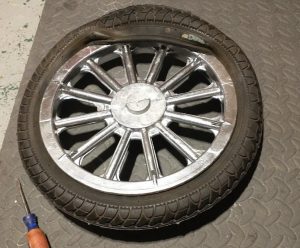
Tire Won’t Fit! What Is Happening!?
Shifting Gears When It Wasn’t What You Wanted To Do
By: Robert Gamble, Prototype Industries
The customer was irate. He had paid a hefty sum for the product — and now it wasn’t working.
“The tires don’t fit!” he said. “I’ve tried bicycle shops and even mechanics, and no one can get them on!”
I tried myself — and sure enough, the tires wouldn’t fit either. What happened?
The simple answer was shrink. Solid cast tools don’t shrink the same way sand tools do. So, the wheels were sent out for re-machining to bring the outer rim down to an acceptable size.
However, even after the rework, I still couldn’t get the tire back on.
Cue panic mode.
Then it hit me — the problem wasn’t the wheel size at all. It was the method.
A tire has to be mounted one side at a time, not both sides simultaneously.
When Engineering Logic Collides with Emotion
This kind of situation is common in engineering — a sudden failure challenges your assumptions and shakes your confidence. The discipline of engineering itself feels under assault when “crazy failures” make us question everything we thought we knew.
The key is not to panic. A calm, methodical approach helps pin down the slippery fish — that unpredictable, erratic-moving target of a problem.
At first, the emotional reaction made perfect sense:
“The tire doesn’t fit — what in the world is happening?”
My own first thought was, “I checked, triple-checked, and quadruple-checked that tool. What changed?”
The Data Tells the Story
Comparing old and new parts revealed a difference in diameter. Hand calculations showed the old parts had experienced significant shrink — about 0.125 inches per foot.
After further digging, I found two contributing factors:
- Solid tools shrink differently than sand tools.
- Rubber pattern molds shrink slowly over time — about 1% over five years.
Here’s what that meant for a 13.043-inch nominal part:
- Sand Mold → 13.043 → 12.85 inches
- Sand Mold with 1% shrunken rubber pattern → 13.043 → 12.72 inches
- Die Cast Mold → 13.043 → about 12.9–13.0 inches
But here’s the kicker: over 200 wheels had already been produced at 12.85 inches — and no one else was complaining.
To be safe, I turned the wheels down to 12.65 inches, ran a test fit — and to my surprise, the tire still wouldn’t go on!
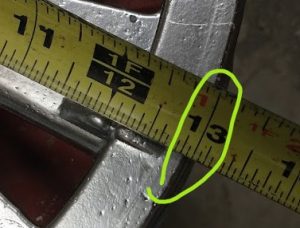
Die Cast Shrinkage 12.9
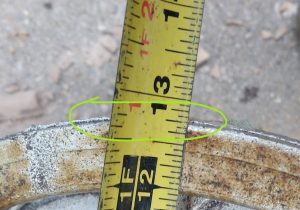
Old Tool Shrinkage 12.7
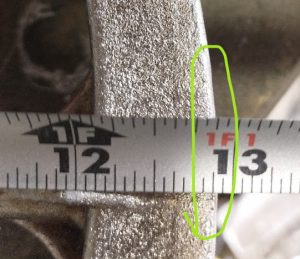
New Tool Shrinkage 12.8
The Real Culprit
At this point, panic could have easily taken over. But I stopped and asked myself:
“How many different ways can a tire go on a rim?”
Really, only two:
- Both sides at once
- One side at a time
The first method — my old habit since I was ten years old — wasn’t working.
The second method — the way tire shops do it — worked perfectly. The rigid scooter tire slipped on easily.
The “problem” wasn’t a problem at all. It was a matter of technique.
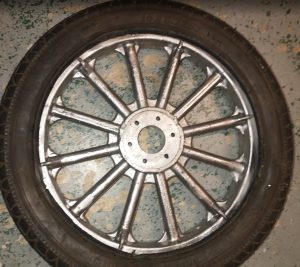
Put first side on rim
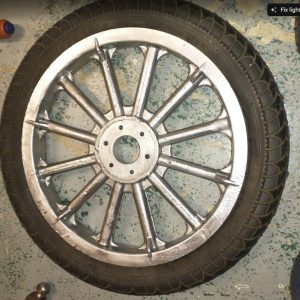
Put second side on rim. Fully installed.
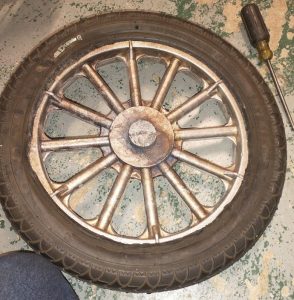
Confirmation test with larger rim, first side on.
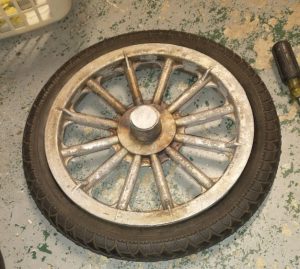
Confirmation test finale, tire fully on rim, newly cast rim.
Lessons Learned
Even though the main issue turned out to be procedural, the incident revealed valuable lessons about part shrinkage:
- Solid Mold Casting Shrinkage:
Solid molds typically shrink between 0.5–1%, while sand molds shrink closer to 1.5%. That difference is significant — especially for longer parts. - Rubber Mold Pattern Shrinkage:
Over time, rubber molds shrink naturally. In this case, a five-year-old rubber pattern had shrunk by about 1%. The surprise was realizing that even unused molds on the shelf continue to shrink slightly each year.
This insight changes how I look at urethane and casting processes. Rubber molds don’t just fail because they break — they fail because they shrink. Depending on the tolerance needs, that may or may not ever be a problem.
Final Thought
Sometimes, shifting gears isn’t what you planned to do — but it’s exactly what you need to do.
Whether it’s a tire that won’t fit or a design that suddenly defies logic, how you handle the unexpected defines the outcome.
Handle it with grace, or handle it with panic.
The choice is yours.
